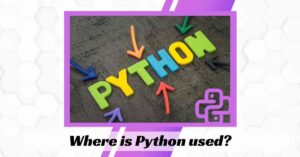Table of Contents
ToggleIntroduction
Python is the most eclectic programming language. It supports multiple programming styles, from basic functional coding to industry-level object-oriented programming. Python has become the best choice of language for OOPs.
Inheritance is the pillar concept of OOPs. Python Inheritance, This article will examine this vital feature and its various types. We must get familiar with some necessary coding concepts like Objects and Classes.
What is Python

In features of Python Programming Language, Python is a general-purpose, dynamic, high-level, and interpreted programming language. It assistances ObjectObject Oriented programming access to develop applications. It is easy to learn and provides many high-level data structures.
Python is an easy-to-learn yet powerful and versatile scripting language, which makes it attractive for Application Development. Python’sPython’s syntax, dynamic typing, and interpreted nature make it an ideal language for scripting and rapid application development.
Python supports multiple programming patterns, including object-oriented, imperative, and functional or procedural programming styles.
Python History
Guido van Rossum invented Python in 1991 at CWI in the Netherlands. Python programming language has been taken from the ABC programming language.
There is also a fact beyond the selecting name Python. Guido van Rossum, a fan of the famous BBC comedy show of that time, “Monty Python’sPython’s Flying Circus.” So he distinct to pick the name Python for his newly created programming language.
Where is Python used?

In features of Python Programming Language, Python is a general-purpose, popular programming language used in almost every technical field. The multiple areas of Python use are given below.
- Data Science
- Data Mining
- Desktop Applications
- Console-based Applications
- Mobile Applications
- Software Development
- Artificial Intelligence
What is Python Inheritance?
Inheritance is the ability to ”inherit” attributes from already written classes into newer classes we make. These features and characteristics are defined data structures and the functions we can perform with them, a.k.a. Methods. It promotes code reusability, considered one of the best industrial coding practices, as it makes the codebase modular. Inheritance is the pillar of the OOPs concept. Classes are used to implement Inheritance.
What is the importance of Python Inheritance?

The inheritance laws that exist in any society significantly impact the productivity rates that exist in its economy. How wealth is transferred across generations changes people’s incentive structure to earn that wealth.
The essential advantages of inheritance are: Reusability – Inheritance allows deriving new classes from existing classes without modification. This helps reusability of information in the child class and adds extra functionality.
Read: data science course pune
Types of Python Inheritance
We are all set with the conditions to understand how Inheritance in Python is accomplished; let’s look at several inheritance types.
Single Python Inheritance
Single Inheritance is the most accessible form of Inheritance where a single child class is obtained from a single parent class. To its candid nature, it is also called Simple Inheritance.
Single inheritance allows an obtained class to inherit properties from a single parent class, thus enabling code reusability and adding new features to existing code.
Multiple Python Inheritance
A single-child class is inherited from two or more parent classes in multiple inheritances. The child can access all the parent classes’ methods and attributes.
However, if two parents have similar “named” methods, the child class executes the method of the first parent in order of reference. We can utilize the Method Resolution Order function to understand better which class’s methods will be implemented first. It tells the order in which the child’s class is taken to visit the other classes.
Multilevel Python Inheritance
In multilevel Inheritance, we go behind just a parent-child relation. We insert grandchildren, great-grandchildren, grandparents, etc. We have seen just two levels of Inheritance with a superior parent class/es and an obtained class/es, but here we can have numerous groups where the parent class/es itself is derived from another class/es.
Hierarchical Pyhton Inheritance
Hierarchical Inheritance is the exact opposite of multiple Inheritance. It means that there are numerous derived child classes from a single-parent class.
When more than one derived class is created from a single base, this type of inheritance is called hierarchical inheritance. This program has a parent (base) class and two child (derived) classes.
Hybrid Python Inheritance
Hybrid Inheritance is the mixture of different kinds of Inheritance. Here we can have many relationships among parent and child classes with multiple levels.
Inheritance consisting of multiple kinds of inheritance is called hybrid inheritance.
Functions in Python Inheritance

Python is a versatile and user-friendly language. It provides some unique in-built attributes that make our lives simpler when understanding Inheritance, especially of a complex nature.
super() function
Method overriding is a capability of any object-oriented programming language that enables a subclass or child class to provide a specific implementation of a method already offered by one of its super-classes or parent classes. Python Inheritance, This difference is caused due to similar naming convention of the methods. We can see this situation when the parent’sparent’s init() is overridden by the child’schild’s init(); hence, the child class cannot inherit attributes from the parent class.
The child class/subclass in the function.
issubclass()
The issubclass() function is an appropriate way to check whether a class is the child of the parent class. In other words, it prevents the first class is derived from the second class. If the classes share a parent-child relationship, it returns a boolean value of True. Otherwise, False.
isinstance()
The isinstance() is another inbuilt function of Python that allows us to check whether an object is an instance of a particular class or any of the classes it has been derived from. It takes two parameters, i.e., the ObjectObject and the class we must check against. Python Inheritance, It returns a boolean True value if the ObjectObject is an instance and, otherwise, False.
Click here to know about: data science course india
Advantages of Python Inheritance
- Modular Codebase: Increases modularity, i.e., breaking down the codebase into modules, making it easier to understand. Here, each class we define becomes a separate module that can be inherited separately by one or many classes.
- Code Reusability: the child class copies all the attributes and methods of the parent class into its class and use. It saves time and coding effort by not rewriting them, thus following modularity paradigms.
- Less Development and Maintenance Costs: changes must be made in the base class, and all derived classes will automatically follow.
- Reusability – Inheritance allows obtaining new classes from existing classes without modification. This helps reusability of information in the child class and adds extra functionality.
Disadvantages of Python Inheritance
- Decreases the Execution Speed: loading multiple classes because they are interdependent
- Tightly Coupled Classes: Even though parent classes can be executed independently, child classes can only be conducted by defining their parent classes.
Conclusion
The inheritance laws that exist in any society significantly impact the productivity rates that exist in its economy. How wealth is transferred across generations changes people’s incentive structure to earn that wealth. Inheritance allows obtaining new classes from existing classes without modification. This helps reusability of information in the child class and adds extra functionality.
Inheritance is the ability to ”inherit” attributes from already written classes into newer classes we make. These features and characteristics are defined data structures and the functions we can perform with them, a.k.a. Methods.
Frequently Asked Questions
What are the different types of inheritance in Python?
- Single Python Inheritance
- Multiple Python Inheritance
- Multilevel Python Inheritance
- Hierarchical Pyhton Inheritance
- Hybrid Python Inheritance
What is super () in Python?
super() function
Method overriding is a capability of any object-oriented programming language that enables a subclass or child class to provide a specific implementation of a method already offered by one of its super-classes or parent classes.
This difference is caused due to similar naming convention of the methods. We can see this situation when the parent’sparent’s init() is overridden by the child’schild’s init(); hence, the child class cannot inherit attributes from the parent class.
What is polymorphism in Python?
The meaning of polymorphism is a condition of occurrence in different forms. Polymorphism is an essential concept in programming. It refers to using a single type entity to represent different types in different scenarios.
What are the 4 types of inheritance?
- Single Python Inheritance
- Multiple Python Inheritance
- Multilevel Python Inheritance
- Hierarchical Pyhton Inheritance













